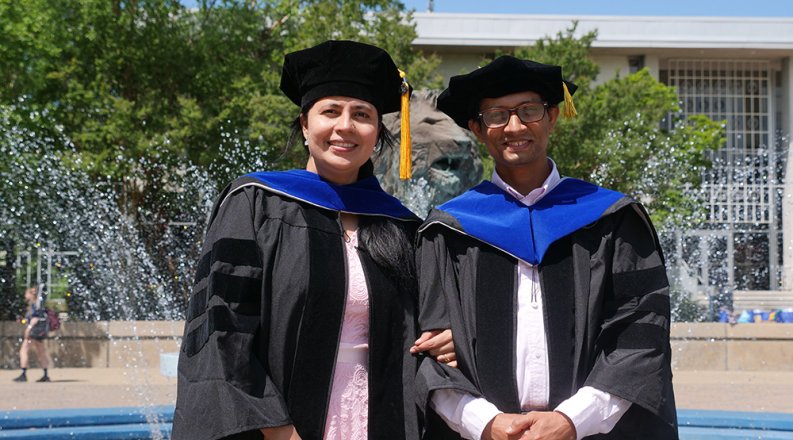By Sunil Pokharel, Ph.D. and Pushpa Pandey, Ph.D.
Husband and wife, Sunil Pokharel, Ph.D. and Pushpa Pandey, Ph.D. started their journey together at Old Dominion University and received their doctoral degrees in physics together on May 6, 2024. Read their story about taking the journey together.
We chose ODU for our Ph.D. degrees for several compelling reasons. My wife had a long-standing dream to pursue her Ph.D. in the USA, and ODU's strong reputation in our respective fields of study made it an attractive choice. The university's renowned faculty members and cutting-edge research facilities provided an ideal environment for her to pursue her academic aspirations.
For me, the decision to follow my wife to ODU the subsequent year was deeply rooted in our commitment to each other. I couldn't bear the thought of being separated from her for an extended period, and I wanted to support her pursuit of her dream while also furthering my own academic and career goals.
With two kids and both of us pursuing Ph.D.’s in physics together, you might wonder how we decided on this path and managed our many responsibilities.
We chose to pursue our Physics degrees simultaneously because of our shared passion for the field and our mutual support for each other's academic aspirations. To manage our roles as husband, wife, father, mother, and student, we relied on careful planning, effective communication, and unwavering dedication.
We established clear schedules and routines to balance our academic pursuits with our family commitments. Additionally, we divided household responsibilities and childcare duties to ensure neither of us felt overwhelmed.
Despite the challenges, our resilience and the support of our extended family and friends helped us successfully navigate this demanding chapter in our lives. The fulfillment derived from pursuing our passions while setting an example for our children made every sacrifice worthwhile.
I, Sunil, completed my undergraduate (B.S. in Physics) and graduate (M.S. in Physics) degrees at the Central Department of Tribhuvan University, Kirtipur, Nepal. Meanwhile, my wife, Pushpa, obtained her degrees from one of the constituent campuses of Tribhuvan University, Birendra Multiple Campus, Bharatpur, Nepal.
We both conducted our research at Jefferson Lab. I focused on accelerator science, with my thesis topic being "CEBAF Injector for K-Long Beam Conditions," under the guidance of Dr. Geoffrey Krafft. I received training at Jefferson Lab in advanced electron injector design and modeling. The upcoming Jefferson Lab KL experiment in CEBAF's Hall D will feature a lower bunch repetition rate of 7.80 MHz or 15.59 MHz. Multi-objective genetic optimizations were performed for the CEBAF injector to determine optimal magnetic elements and RF settings for KL bunch charge. Subsequent beam dynamics simulations and measurements were conducted to obtain beam characteristics in the front end of the CEBAF injector.
Meanwhile, my wife, Pushpa Pandey, conducted experimental nuclear physics research at Jefferson Lab. Her thesis, titled "Longitudinal Solid Polarized Target for CLAS12 and Study of Spin Structure of Nucleons," was supervised by Dr. Sebastian E. Kuhn. During my Ph.D., I primarily worked as an experimental nuclear physicist and assisted the JLab Target Group in building the longitudinal Solid Polarized Target for experiments using the CLAS12 detector of Hall B in JLab,” said Pandey. She is now working at Jefferson Lab as a Postdoctoral Associate for the Massachusetts Institute of Technology.



